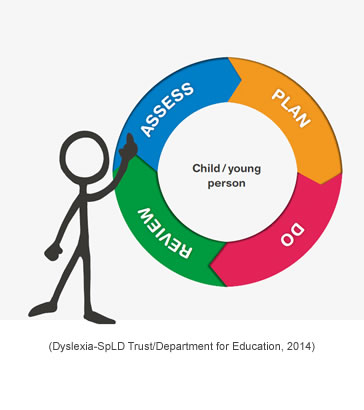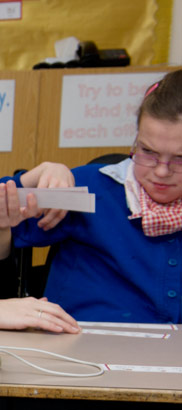The regular monitoring and assessment of the progress
and development of all
pupils by class and subject teachers, supported by their senior leadership team, should
provide the basis for identifying special educational needs/disabilities. This can
be across areas of social/emotional well-being as well as attainment.
Pupils making less than expected progress given their age and individual circumstances will demonstrate progress that:
- Is significantly slower than that of their peers starting from the same baseline;
- Fails to match or better the child’s previous rate
of progress; - Fails to close the attainment gap between the child and their peers;
- Widens the attainment gap.
Based on the school’s census data and/or its special educational needs/disability register, the leadership team, the SENCO and teaching staff should identify any patterns in the identification of special educational needs, both within the school and in comparison with national data. Based on their findings, they should review and reinforce the quality of teaching. (0-25 SEND Code of Practice, sections 6.4-6.18)
For whole school approaches, see the Achievement for All appendix, 'Improving practice and staff training in education settings'.
It is important that there is no delay in making necessary special educational provision (0-25 SEND Code of Practice, 2015 (CoP), section 5.36).
There are four levels of response when teachers are concerned that a child/young person may have special educational needs/disabilities described by the 0-25 SEND Code of Practice (2015) (CoP). If a child's/young person’s needs cannot be met at one level, it indicates a need for the next:
- Confirmation that the child/young person is receiving high quality teaching that is differentiated, personalised and targeted at their areas of weakness (CoP, sections 1.24, 6.37, 7.4, 7.10-7.12);
- Investigation of the need for 'SEN support' (CoP, sections 5.36-5.48, 6.44-6.63, 7.13-7.35);
- Application for high needs funding; or
- Education, Health and Care Needs Assessment (CoP, sections 5.49, 6.63, 7.23; chapter 9).
These are applied within the context of ongoing monitoring, assessment, evaluation and review of the child's/young person’s needs, progress and development.
'[Education] providers must have arrangements in place to support children with SEN or disabilities. These arrangements should include a clear approach to identifying and responding to SEN.' (0-25 SEND Code of Practice, 2015 (CoP, section 5.4))
The basis of identification and action are focused on:
(a) Identifying those children/young people who require additional support; and
(b) Assessing their strengths and difficulties to plan that support.
In summary, there are three phases that practitioners should put in place:
- Ongoing monitoring and review of the progress and development of all children/young people (CoP, section 5.27);
- Skills assessment (including parent/child/young person involvement): Considering all the information about the child’s learning and development from within and beyond the setting (CoP, section 5.28);
- Comprehensive assessment: To determine any causal factors apart from or in addition to an underlying learning or communication difficulty (CoP, section 5.29, 5.30).
List the actions you should carry out to support these activities. Click here to find out tasks that teachers should undertake.

The need of children/young people for ‘SEN support’ is based on the assumption that they are already receiving ‘high quality teaching that is differentiated and personalised [to] meet the individual needs of the majority of children and young people’ (0-25 SEND Code of Practice, 2015, section 1.24).
Consider the relevant aspects of the following two documents in relation to the principles of high quality teaching:
Leading
on Interventions (Department for Education/
Department for Education and Skills,
2006)
What do we really mean by ‘quality first teaching' for the more able? (Dickenson, n.d.)
Discuss or summarise in writing what ‘quality first teaching’ might look like for children with special educational needs/disability in your school?

The 'graduated approach' is a key component of 'SEN support' and Education, Health and Care planning. All educational settings should adopt this approach (0-25 SEND Code of Practice, 2015 (CoP), sections 5.38, 6.44, 7.14).
The 2014 special educational needs/disability framework bases the 'graduated approach' on the following action stages:
For further information on this approach, turn to the 0-25 SEND Code of Practice (2015; sections 5.36-5.47 (early years), 6.44-6.56 (schools), 7.14-7.21 (further education).
Although this approach is described primarily in relation to 'SEN support', the approach also underpins Education, Health and Care Planning and provision.

‘Where, despite the setting having taken relevant and purposeful action to identify,
assess and meet the special educational needs of the child, the child has not made
expected progress, the setting should consider requesting an Education, Health and
Care needs assessment (see Chapter 9, Education, Health and Care Needs Assessments
and Plans).’
(0-25 SEND Code of Practice, 2015, section 5.49; see also
section, 6.63, 7.23, Chapter 9)

'Early action to address identified needs is critical to the future progress and improved outcomes that are essential in helping the child to prepare for adult life...– identifying need at the earliest point and then making effective provision improves long-term outcomes for the child or young person.' (0-25 SEND Code of Practice, 2015, sections 5.36, 6.14)
Educational aspirations and outcomes of service providers need to be aligned with the child's/young person’s own aspirations and outcomes, together with those of their parents. In most cases, service provider’s aspirations and outcomes are the means through which personal aspirations and outcomes can be realised. It is crucial that they are in synergy rather than in conflict.
The graduated approach – assess, plan, do, review – is the vehicle through which this alignment can take place (CoP, sections, 5.40-5.43).
For more information on early years outcomes, link to the Early Years Foundation Stage framework and the guide to early years outcomes/non-statutory Early Years Outcomes guidance.


- Department for Education and Skills (2006) Leading on Intervention: A resource to support leadership teams and leading teachers. Annesley: DfES Publications.
- Dickenson, M. (n.d.) ‘What do we really mean by Quality First Teaching?’
(Presentation). London: London G&T/ matt.dickenson@londongt.org. [Online at: http://www.learning-
works.org.uk/11-matt-dickenson-sat-w4-pdf; accessed: 14.3.15] - Dyslexia-SpLD Trust/Department for Education (2014) Guidance: Supporting
schools and local authorities to implement the SEND reforms for children and young
people with literacy difficulties, specific learning difficulties and dyslexia.
Bracknell: The Dyslexia-SpLD Trust/DfE. [Online at: http://www.thedyslexia-spldtrust.org.uk/4/resources/2/for-
schools-and-local-authorities/279/online-guidance-on-the-sen-
reforms/; accessed: 16.3.15]